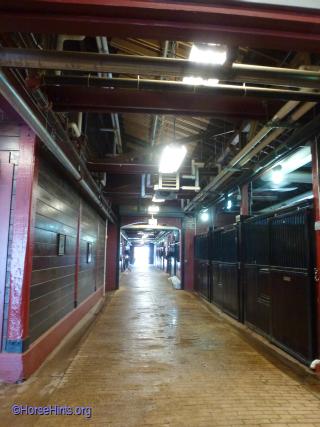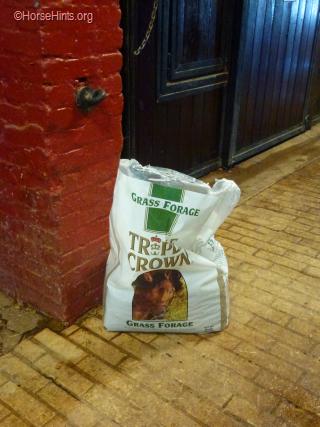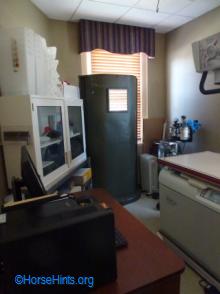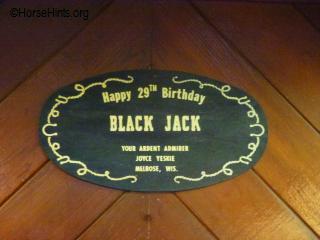| Home Fed. Govt./Horses Kids Corner | First Posted: Oct 14, 2013 Jan 21, 2020 | |
Caisson Horsesby Debora Johnson
Our equine vet, of many years, Dr. Nancy Sitarz, now gives tender loving care to the Caisson Horses at Ft. Myer. She is no longer in private practice but is using her wisdom to keep these exceptional horses and the war dogs well. I can tell you that they are very fortunate to have Dr. Sitarz, indeed. She has a 6th sense about the animals and is able to figure out problems that many others would miss. Bill and I have always said that "Dr. Nancy" has an uncanny ability to diagnose and treat like no other equine vet. She saved the lives of several of our horses. One of them was a Thoroughbred, pasture name, Little Bee, race name, GoVanGough, who impaled herself on an uprooted tree limb. The hole was so deep you could see the lungs and heart. Nancy did the operation in the field as there was no time to get to an equine hospital. She saved the Little Bee's life and the horse, once healed, was perfectly sound. Gambler's Gold Star, another one of our horses, tied up and Nancy stayed hours into the freezing winter night providing care. It is a miracle that both these horses lived and were sound once again! She also diagnosed a parasite that no other vet could figure out. That parasite was onchocera; a parasite that many vets have never seen. Two horses that we had purchased in the south, as colts, had that parasite and no one knew. At two years of age the symptoms started to show and Nancy nailed it immediatly! Dr. Sitarz told us to have meds compounded to treat it and exactly which compounding company to use. Of course, she also explained exactly how to administer the meds. We used them for the lifetime of the horse. We cannot say enough good about Nancy. She is really beyond amazing.  Nancy Sitarz, Caisson Horse and War Dog Vet About the Caisson Horses There are always 60 caisson horses. There are 40 horses that are stabled at Ft. Myer and 20 horses that are stabled at Ft. Belvoir. Generally there are eight full honor funerals each day, splitting the workload between two riding teams for a total of four funerals per day for each team. However, there can be as many of 16 burials a day at Arlington Cemetary. "The platoon conducts an average of 1,700 funerals per year between all five service branches. The honor is reserved for all officers, warrant officers, sergeants major (E-9, the highest enlisted rank) and anyone killed in the line of duty...Priority is to those killed in action..." Stars and Stripes It should be noted that these caisson horses are rotated and rest between missions. The caisson horses work a two week shift of cemetary duty. After that two weeks they are given R&R at Ft. Belvoir and another twenty of the rested caisson horses are brought to Ft. Myer for their two week shift of cemetary duty. Their mission is physically and psychologically demanding. The horses must be well disciplined, standing still for long periods of time, being steady and not reacting to anything that might be a disturbance. Always remember that a horse's natural instinct is to take flight for protection. They are prey animals. The caisson horses must learn to override their instincts and work in a partnership with their human team mates. Of course, there is supposed to be silence when the caisson procession winds its way through Arlington National Cemetary. This procession is at an extremely slow walk, very deliberate--which can actually be difficult for the horses. The riders must be in perfect riding position. It should also be noted that the men rotate out every 18 months. Bonding between horses and man need to take place quickly. To be a part of this honor takes constant practice and precision. The other 20 horses stay at Ft. Belvoir and work with the Wounded Warrior Program. Wounded Warrior Program at Ft. Belvoir and the caisson horses Interesting Facts About the Caisson Horses
More Images of the Caisson Horse Area at Ft. Myer   Left: Inside the Caisson Horse Barn. Right: Lucky eats only Triple Crown!
A View of Inside the Clinic (Vets Work Area).
  Honor Guard's Platoon About TOG "The 3d U.S. Infantry Regiment (The Old Guard) is the face of the Army. Old Guard Soldiers represent all Soldiers in ceremonies in the National Capitol Region and throughout the nation. The 3d U.S. Infantry Regiment (The Old Guard) is the official Escort to the President of the United States and our nation's Premier Memorial Affairs and Ceremonial Unit. Old Guard Soldiers are in Arlington National Cemetery daily rendering final honors to our fallen, both past and present. The 3d U.S. Infantry Regiment (The Old Guard) is the oldest active Infantry Regiment in the U.S. Army and has a distinguished history of service throughout our nation's conflicts; from its creation in 1784 through Operation Iraqi Freedom. Old Guard Soldiers are tactically proficient in their soldiering skills. Besides our ceremonial duties we stand ready to defend the National Capitol Region in the event of an emergency." Follow this link and read all about the 1/3 Battalion HHC Caisson Platoon: 1/3 Battalion HHC Caisson PlatoonA Word About Black Jack 
Black Jack was foaled January 19, 1947, and came to Fort Myer from Fort Reno, Oklahoma, on November 22, 1952. Black Jack was the last of the Quartermaster-issue horses branded with the Army's U.S. brand (on the left shoulder) and his Army serial number 2V56 (on the left side of his neck). He died on February 6, 1976, and was buried on the parade ground of Fort Myer's Summerall Field with full military honors, one of only two US Army horses to be given that honor. Black Jack Caisson Horse/Most Famous Riderless Horse A Word About the Riderless Horse The riderless horse named Sergeant York aka Allaboard Jules, during the funeral procession for the 40th President of the United States, Ronald Reagan, with President Reagan's boots reversed in the stirrups. A riderless horse or caparisoned horse (in reference to its ornamental coverings, which have a detailed protocol of their own) is a single horse, without a rider, and with boots reversed in the stirrups, which sometimes accompanies a funeral procession. The horse follows the caisson carrying the casket. The custom is believed to date back to the time of Genghis Khan, when a horse was sacrificed to serve the fallen warrior in the next world. The caparisoned horse later came to symbolize a warrior who would ride no more. Others suggest that this tradition hailed from over a thousand years before Genghis Khan, when the Afghan people represented the Buddha as a riderless horse. In the United States, the caparisoned horse is part of the military honors given to an Army or Marine Corps officer who was a colonel or above; this includes the President, by virtue of having been the country's commander in chief and the Secretary of Defense, having overseen the armed forces. Abraham Lincoln was the first president of the United States to be officially honored by the inclusion of the caparisoned horse in his funeral cortege, although a letter from George Washington's personal secretary recorded the president's horse was part of the president's funeral, carrying his saddle, pistols, and holsters. Traditionally, simple black riding boots are reversed in the stirrups to represent a fallen leader looking back on his troops for the last time. For More Information: Mucking About With the Old GuardMucking About With the Old Guard/Part 2 Mucking About With the Old Guard/Part 3 The Caisson Platoon Equine Assisted Programs Caisson Horse Articles |